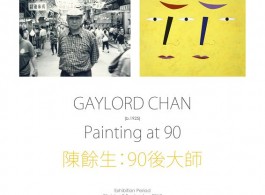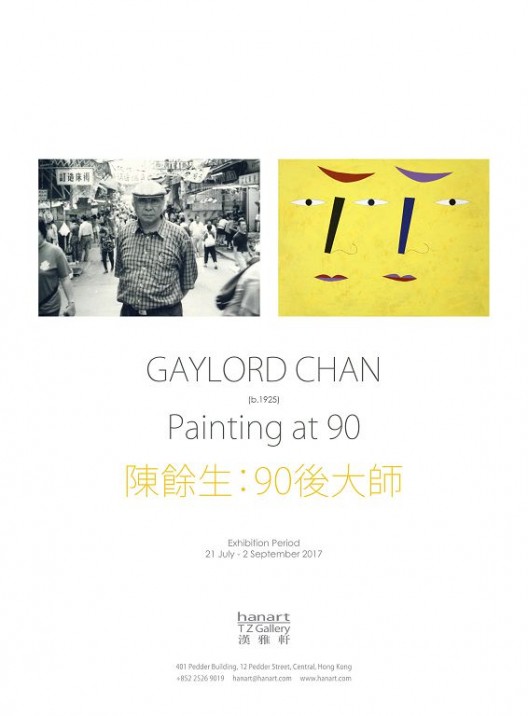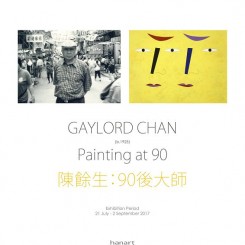Hanart TZ Gallery is pleased to announce the opening of Painting at 90, a solo exhibition of works by Hong Kong master Gaylord Chan, on Friday, 21 July 2017. The exhibition will run through 9 September.
The exhibition will feature a range of Gaylord Chan’s works from the late 1980s to his latest pieces, including his earlier oil paintings to his latest ‘computer paintings’ and ‘laser-cut-wood-paintings’. His series of works show his ready wit and earthy happiness by keeping alive a search for arcane refinements in the profession of painting. The concern for movement in form, emotion in colour combination, spatial balance and depth of field, are both underscored and overlayed by Chan’s passion and sense of humour.
A Painter of the In-Between World
Ian Findlay-Brown
At the age of 90, Hong Kong artist Gaylord Chan is a tsunami of energy. It is an essential energy, one that has compelled his prolific art making. His robust oeuvre shows that he has never been afraid to experiment and over the decades he has used a variety of media, from painting to textiles to computer-generated prints. His recent ‘laser-cut wood paintings’ also powerfully address this willingness to experiment. One sees in his art a poetic narrative where colour, geometry, and edgy symbolism encourage viewers to reverie.
At the outset of their careers many artists have a personal vision through which they aspire to develop a socio-political position that demands their urgent attention. This is not so for Chan. ‘I thought the world was so funny,’ he recalls. ‘In school, I doodled on pieces of paper, and these doodles became my immediate expression on life. Most importantly, I wanted to try to express my humanity in every aspect of myself, including art, which is very difficult.1
Chan’s art is by turns wistful, humorous, sad, erotic, poetic, direct, lyrical, and instinctively symbolic. It is rarely sentimental. His abstract narrative is fresh, with its origins in his youth, but with the immediacy of the present. Paintings such as Three Red Holes (1989), Here I Come (1993), Golden Nucleus (2003), and Bifocal (2009) and computer-generated prints such as Bridge (2011), Torch (2011), Divider (2013), Marching (2014) and Butterfly (2014), all speak to Chan’s unique methods and his ability to conjure up magical scenarios from seemingly slight material. Yet the work is far from simple in its vitality.
‘When I look at an empty canvas, it is so inviting,’ he says. ‘I make a few lines and then rub them and then I put on some colour, and then I make a few forms. I change and I cover it up. Then it starts rolling all by itself: the painting dances with me. Every piece of my work has life in it. So it is a living thing by the time I stop painting it. If it doesn’t have life in it, I delete it by painting it over or, if I am working on the computer, I click and delete it.’2
Gaylord Chan’s life and his art are twin obsessions: each illuminates the other as they are joined seamlessly in his paintings and prints. Here there is a realm of human brightness where his heart beats most strongly. As the late architect, artist and teacher Tao Ho noted in 1991 of Chan’s work (and as is true to this day), ‘… each painting represents a spontaneous beat from his heart. He paints what he feels. … He lets his heart guide his hand.’3 And as Tao Ho also noted, each of Chan’s colours ‘is weighted for an exact level of intensity and value to express vibration, tension, light, space, and energy. He has a rare gift for harmony, although it is not harmony in the conventional sense … the painting always holds together as a powerful visual entity.’4
All the qualities Tao Ho mentions are fragments of Chan’s evolving soul, which have their beginnings in his life as a young man living in Hong Kong under the barbarous conditions of World War II. Born in Hong Kong in 1925, Chan was a teenager surviving in a merciless time, all the while subliminally filing away experiences of survival that would become integral elements in his later art. The drama and joy of many of Chan’s images are a salve for distant traumas and a solace for viewers. His art shows a deep understanding of human pain and the questioning of self. He has spontaneously mined his life and discovered a singular lyricism in line and symbolism that suggests that the suffering of the past is best left there, to linger at the edge of memory.
In 2001, as Chan grew older and was no longer able to stand for long periods to paint, he began to make art on the computer. His successes in digital prints introduced him to a new future where he could mine his psyche for new narrative challenges, merging dreams and philosophies, fantastical and surreal imaginings, and playing with a unique range of colours not available to him in paint.
‘The only control the artist has is his own vision in his mind.’ Chan says. ‘The lines you draw don’t come out from a brush or pen in one’s hand. The colours on the screen are the luminosities created by materials irritated by electrons. Form, colours, line, and textures are all in the cyber-world, from cyber to reality.’5
Chan embraces the quirks of his imagination: they enhance the dynamic of his artistic voice. He works firmly in the present, conveying nuances of his past and, though he may be blocked momentarily, he is not tormented by angst. His lovely digital print titled Embrace (2014) speaks to creative freedom. Gaylord Chan is like a dancer working through physical pain. He adjusts his focus to the main event: making art.
As Chan says of his work and of his life: ‘I always question: Why are we here? What is consciousness? Where does it go when we sleep? I have three kinds of dreams. The first is prophetic. The second is hyper-realistic although the things in the dream are purely imaginary. The environment is clear. I have places to visit. The third type of dream is that I can’t seem to decide whether I am awake or dreaming….’
Excepted and adapted from the essay A Painter of the In-Between World by Ian Findlay-Brown, Asian Art News, Volume 25 Number 6, November/December 2015.
Notes:
1 In conversation with Gaylord Chan, August 4, 2015, Taipo, New Territories, Hong Kong. Unless otherwise stated, all quotations are from this meeting.
2 In conversation with Gaylord Chan, Taipo, New Territories, Hong Kong, December 18, 2015.
3 Tao Ho, ‘Painting from the Heart’, Gaylord Chan, exh. cat., Hanart TZ Gallery, Hong Kong, 1991.
4 Ibid.
5 Gaylord Chan’s statement on hybrid art, recorded on November 11, 2006, for the author.
Artist Biography
Gaylord Chan (b.1925)
Gaylord Chan did not take up painting until he was 42 years old. In his early life he worked at Cable and Wireless Plc as special advisor and OLUHO (Okinawa Lusong Island Hong Kong) Submarine communications cable project. His expertise was in air waves and frequencies, rather than in form and colour. Yet his interest in and passion for the vividness of life around him led him to seek out art as a means of expression. In 1968 Gaylord began to study visual arts at the University of Hong Kong’s Extramural Studies Centre, and he never looked back. He soon became a dedicated painter, and one of the most active members of the early Hong Kong contemporary arts scene. Gaylord was the co-founder of the Hong Kong Visual Arts Society in 1974 and was a founding member of the Artmatch Group in 1995. Awarded an MBE in 1986, he was also the recipient of the ‘Artist of the Year Award’ from Hong Kong Artists Guild in 1990, and Bronze Bauhinia Star from the HKSAR Government in 2013. In 1989 he and Josephine Chow co-founded the Culture Corner Academy, a teaching studio which has mentored dozens of artists over the years, as well as inspired many others to make art an integral part of their lives.
Gaylord Chan describes his paintings as conversations between himself and the canvas. He says each work is spontaneous and springs from the heart. He is inspired by anything, from a plain bottle of pills to a display of Eskimo art to drawings by his students. Once an idea is formed, he says he feels driven to put it on canvas. Chan admires modern and contemporary masters both East and West, such as Francis Bacon, Joseph Beuys, Anselm Kiefer, Huang Binhong, Qi Baishi and Xu Wei, but also reacts strongly to primitive art. While he has nurtured a singular style, he continues to experiment with various media, gaining a reputation for originality and for an enduring iconography in his work.
Oscillating between the figurative and the abstract, Gaylord Chan’s art is known for its simplicity, invigorating ordinary things with a unique pictorial composition. In 1997, Gaylord was commissioned by the MTR Hong Kong to create a monumental mural Swift and Safe that is permanently displayed in the main subway from Hong Kong Station to Central Station.
For health reasons, he rechanneled his artistic creativity from painting to computer drawings. Using basic computer software, Chan has developed a brand new language of artistic expression. At the age of 92, the artist retains his passion and enthusiasm for artistic creativity having created with 400 digital paintings in the past decade, as well as designs for unique textile creations. Gaylord has participated in over a hundred major exhibitions both locally and internationally and his work can be found in major institutional and private collections worldwide.



